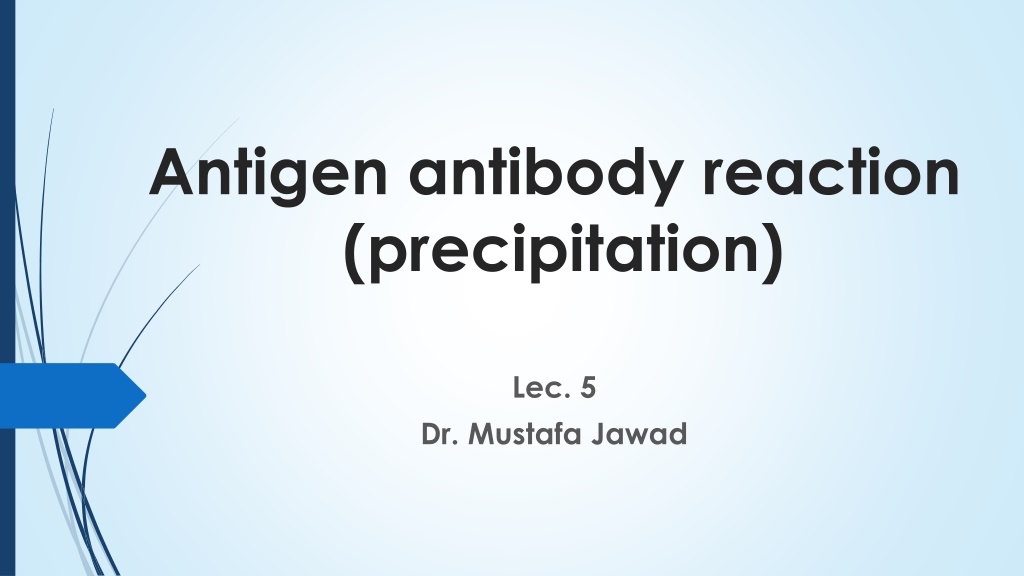Understanding Antigen-Antibody Precipitation Reaction in Immunity
The humoral basis of immunity involves the specific reaction between antigens and antibodies, resulting in the formation of insoluble precipitates through a process called precipitation. This reaction plays a crucial role in immune responses against infectious diseases, influenced by factors like affinity, avidity, sensitivity, and specificity. Precipitation reactions can occur in liquid or gel mediums, with distinct phases known as the zone phenomenon. Applications of precipitation include the detection of antigens, showcasing its significance in immunoassays.
Download Presentation

Please find below an Image/Link to download the presentation.
The content on the website is provided AS IS for your information and personal use only. It may not be sold, licensed, or shared on other websites without obtaining consent from the author. Download presentation by click this link. If you encounter any issues during the download, it is possible that the publisher has removed the file from their server.
E N D
Presentation Transcript
Antigen antibody reaction (precipitation) Lec. 5 Dr. Mustafa Jawad
Introduction The humoral basis of immunity was established at the early 18th century. Following injection of antigen into the animal, certain substances appeared in the serum and the tissue fluid called antibody, which reacted with the antigen specifically in an observable manner. Depending on the type of reaction, the antibodies were known as agglutinin, precipitin and complement-fixing antibodies and so on. Sera having a higher antibody level are known as immune sera. When specific Ag and Ab mixed together in solution it react to forming complex It important in Ab-mediated immunity against infectious disease Ag-Ab reaction is highly specific Ag-Ab reaction is affected by affinity and avidity
Definitions Affinity: is the intensity of attraction between antigen and antibody Avidity: is the binding strength of the individual Ab with its specific antigenic determinants Sensitivity: It is the ability of the test to detect even very minute quantities of Ag or Ab. When a test is highly sensitive, false negative results will be absent or minimal. Specificity: It is the ability of the test to detect reactions between homologous Ags and Abs only. In a highly specific test, false positive reactions will be absent or minimal. Cross-reaction: reaction of one antigen with antibodies developed against another antigen or antibody raised against one specific antigen recognizes two antigens that have similar structural regions. lattice hypothesis: the formation of bridge by divalent Ab between two Ag molecules. Ag being multivalent can combine with a number of Ab molecules it form lattice makes the reaction visible.
Precipitation Precipitation: It is a reaction between soluble Ag with its Ab in the presence of electrolytes at a suitable temperature (37 C) and pH (7.4) resulting in Ag-Ab complex formation as an insoluble precipitate Flocculation: It is a precipitation reaction in which the precipitates of Ag-Ab complex remain suspended as floccules instead of sedimentation Precipitation occurs most abundantly and rapidly when Ag and Ab are present in optimum proportion. Precipitation reaction can take place in a liquid medium or in semisolid medium (gels) such as agar gels, agarose or polyacrylamide gels Zone phenomenon: If the amount of precipitate in different tubes is plotted, the resulting curve will have three different phases: 1 . A zone of Ab excess (prozone)-in which some uncombined Ab is present 2. A zone of equivalence-in which Ag and Ab are completely precipitated 3. A zone of Ag excess (postzone)-in which all Abs have combined with Ag but some uncombined Ag is present
Applications of Precipitation Precipitation and flocculation reactions are used for: 1- Detection of Ag: more sensitive for detection of Ag and can detect as little as 1 g of protein antigen 2- Detection of Ab: less sensitive for detection of Abs 3- identification of human blood or seminal fluid 4- Standardization of toxins and antitoxins The test can be performed either as a qualitative test or as a quantitative test The qualitative precipitation test is widely used for detection of : - Identification of bacteria - Identification of microbial components in infective tissues, e.g. Bacillus anthracis - Demonstration of antibody, e.g. VDRL (Venereal Disease Research Laboratory) test for syphilis
The techniques of precipitation and flocculation 1- Ring Test: ring of precipitate forms at the junction of two fluids of Ag+Ab 2- Slide Flocculation Test: the form of floccules of Ag and serum on a slide 3- Tube Flocculation Test: Ag and serum are placed in a tube mix to form floccules 4- immunodiffusion Test: It is precipitation in gel, which is more sensitive and specific than precipitation in a liquid medium. Types of lmmunodiffusion A- Single Diffusion in One Dimension (Oudin Procedure) B- Double Diffusion in One Dimension (Oakley Fulthorpe Procedure) C- Single Diffusion in Two Dimensions (Radial lmmunodiffusion or Mancini method) D- Double Diffusion in Two Dimensions (Ouchterlony Procedure) E- lmmunoelectrophoresis (IEP) F- Counter Current lmmunoelectrophoresis (CIEP) G- Rocket Electrophoresis (One-dimensional Single Electroimmunodiffusion) H- Two Dimensional lmmunoelectropboresis (Laurell s procedure)
A- Single Diffusion in One Dimension (Oudin Procedure) In this test, the antibody is incorporated in agar gel and the antigen solution is layered over it The antigen diffuses downward, reacts with antibody and forms precipitation band. The number of bands indicates the number of Ags in a mixture
B- Double Diffusion in One Dimension (Oakley Fulthorpe Procedure) In this test, both Ag and Ab move towards each other by diffusion The Ab incorporated in agar gel is placed at the bottom of tube Above this, a column of plain agar is added On the top of column of plain agar Ag solution is layered Ag and Ab move towards each other through the column of plain agar and form a band of precipitate
C- Single Diffusion in Two Dimensions (Radial lmmunodiffusion or Mancini method) In this test, the Ab is incorporated in agar gel and poured on a glass slide or Petri dish and is allowed to cool and set Wells are cut in layer of agar The Ag diffuses radially and reacts with Ab in gel forming ring- shaped bands of precipitation The diameter of the ring (halos) is directly proportional to the Ag concentration and gives an estimate of the concentration of the antigen
D- Double Diffusion in Two Dimensions (Ouchterlony Procedure) It is also known as agar gel diffusion in which wells are punched in agar gel The antiserum is placed in the central well and different Ags are placed in the surrounding wells The slide is then placed in a moist chamber to prevent drying and to allow diffusion for 24 hours or more The result is formation of precipitation bands where they meet in optimum proportion If two adjacent Ags are identical, the lines of precipitate formed will fuse. If they are not identical, the lines will cross each other.
E- lmmunoelectrophoresis (IEP) It is a combination of electrophoresis and agar gel diffusion The test is done in two steps - In first step, the Ag is subjected to electrophoretic separation in agar gel - In second step, a trough is cut parallel to and slightly away from the path of electrophoretic separation and is filled with antiserum and allowed to diffuse The Ag and Ab diffuse towards each other and form precipitation bands
F- Counter Current lmmunoelectrophoresis (CIEP) In this test, Ab is placed in one well and Ag to be tested in another well and are moved through gel with the help of electric current. The result is formation of line of precipitation when Ag and Ab meet in optimum proportion
G- Rocket Electrophoresis (One-dimensional Single Electroimmunodiffusion) In this test, the Ab is incorporated in agarose gel and poured on a slide or plate Wells are punched on cathodal side and filled with known and unknown Ags and electrophoresis is carried out The result is formation of rocket shaped bands. Based on the height of rocket, the concentration of Ag is quantitated
H- Two Dimensional lmmunoelectropboresis (Laurell s procedure) This test is carried out in two steps: In the first step (first electrophoresis )-Ag is separated by gel electrophoresis in the different parts of gel In the second step-second electrophoresis is carried out at right angle to the first into Ab- containing agar gel This causes migration of Ags into stationary Abs and results into formation of cones of precipitate. Each cone indicates one antigen























